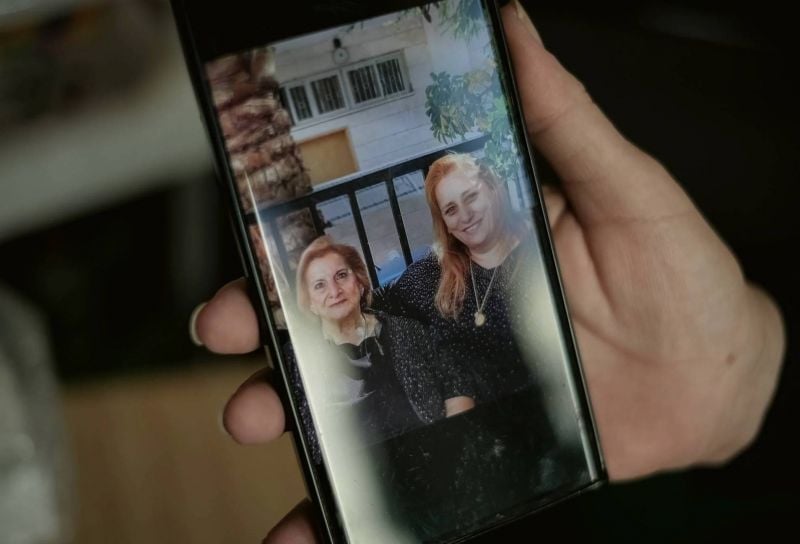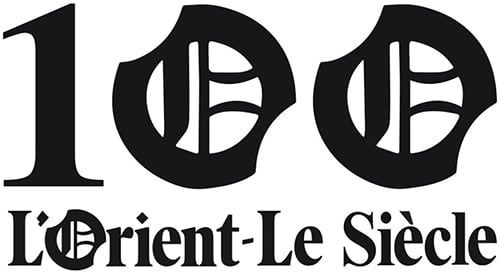
Ghattas shows a picture of her relatives Nahida Boulous and Samar Antoun, who were killed in Gaza on Dec. 16, 2023. (Credit: João Sousa/L'Orient Today)
“I’ll tell you the whole story”
With teary eyes, Saada Ghattas gathers herself as best she can.
In her mini-market in the Palestinian refugee camp of Dbayeh (Metn), the shopkeeper recounts the story of her aunt Nahida Boulous, in her sixties, and cousin Samar Antoun, in her forties, who were tragically killed on Dec. 16 by Israeli snipers in the heart of the Holy Family parish, in the Gaza Strip, according to a press release from the Latin Patriarchate of Jerusalem published the following day.
The Israeli army quickly denied the incident, claiming that there was no fighting in the area.
While war raged in the Gaza Strip, their deaths garnered international attention. On Dec. 17, the day after the incident, at the end of the Angelus prayer, Pope Francis commemorated them, condemning what he called the “targeting” of unarmed civilians.
 Saada Ghattas lives in Lebanon's Dbayeh refugee camp. (Credit: João Sousa/L'Orient Today)
Saada Ghattas lives in Lebanon's Dbayeh refugee camp. (Credit: João Sousa/L'Orient Today)
Since Oct. 7, Ghattas has been carrying a heavy burden. It’s been 100 days of waiting for news about around 20 other relatives, some of whom are still sheltered in the same church.
For 100 days, she clung to the hope that her relatives were still alive, only to face the unsettling reality that “they might not be” tomorrow.
“What’s to prevent them from being killed? Every day, emotionally, it’s getting worse... We know that this war is going to be long,” Ghattas said.
As she recounted the lives of Nahida Boulos and her mother Samar Antoun, Ghattas also retraced, through them, the history of the Palestinians in the region — a tale of never-ending exile.
From Dbayeh to Sanaa
The early chapters of Boulos’ life unfolded in the Palestinian refugee camp of Dbayeh, which was established by the United Nations Relief and Works Agency for Palestine Refugees (UNRWA) in 1953.
Her parents settled there after escaping their village of al-Bassa during the Nakba in 1948, along with many other Christians from the same village and Kfar Berem, both near the Lebanon border.
Boulos’ husband was a fighter with the Palestine Liberation Organization (PLO). Together they had six children. Antoun was the eldest.
In May 1973, two years before the outbreak of the Civil War in Lebanon, deadly clashes between the Fedayeen [guerilla fighters] and the Lebanese Army compelled them to leave Dbayeh. The couple, along with her husband’s family, relocated to Hamra, where they resided for almost a decade until the events of the summer of 1982 unfolded.
Operation “Peace in Galilee” was initiated, marking Israel’s invasion of Lebanon. By mid-June, the Israeli forces gained control of half the country and besieged West Beirut, primarily under the influence of the PLO.
The stated objective was to defeat the organization and its leader, Yasser Arafat.
“At that time, unlike other members of my family, I was living with an uncle in the Acar building in Sanayeh,” Ghattas said. “My father, a PLO lieutenant, had sent me there, thinking it was safer because the organization didn’t have an office there.”
On Aug. 6, 1982, Ghattas woke up to the sound of “Israeli air raids”.
“I was just a child. I got scared and asked to go back to my parents.”
When she arrived at her parents’ house, she asked her father to go and get her things.
She never saw him again. The Acar building was bombed: Arafat, who had been there a few minutes earlier, according to witnesses at the time, narrowly escaped death.
Ghattas’ father was killed.
“After his death, we decided to leave”, she said. In mid-August, an agreement negotiated by US envoy Philip Habib allowed Palestinian fighters and officials to be evacuated to Tunisia, Algeria, Egypt, Iraq, Jordan, Sudan, Syria and Yemen.
Yemen was the destination of the Boulos and Ghattas families.
“We left with nothing. It took us 19 days to get to Sanaa,” Ghattas said.
Boulos like everyone else, had the soul of the resistance. “We were all very close and looked after each other,” Ghattas added.
But in 1985, their exile was disrupted by dark accusations with sectarian undertones: “My grandmother wanted to leave because we were accused of being spies for the Kataeb. We met Abu Ammar [Arafat’s nickname] with my mother and grandmother.”
“She was a strong woman, and she didn’t hesitate to tell him: ‘After everything we’ve sacrificed, this is how we’re being treated,’” Ghattas recounted.
“My grandmother mustered the courage to ask him: ‘Where can we go now?’” she added. Arafat replied, “You are the ones [the Palestinians] of 1948, the ones who came to Lebanon,” insinuating that this was where they belonged.
It was time to go back.
 View of Lebanon's Dbayeh refugee camp. (Credit: João Sousa/L'Orient Today)
View of Lebanon's Dbayeh refugee camp. (Credit: João Sousa/L'Orient Today)
Return to Gaza
The three women left Yemen the same year via Syria and resettled in Dbayeh. Boulos, her children, and Ghattas’ uncles stayed there for another decade before leaving for Gaza.
After more than two decades in exile, Arafat returned to the Palestinian territories in 1994, following the Oslo Accords and the Gaza-Jericho Accords.
“They came back with him and settled in Gaza,” Ghattas said.
In Gaza, Boulos’ family rebuilt their lives there.
“It was difficult at first because of their Christian faith, but over time they got to know priests and integrated,” Ghattas recounted.
Boulos’ children got married and started their own families. Her daughter Samar was still single. They had a good life, living in tower blocks.
“Gaza was more advanced than Lebanon. They were at home, and we envied them,” Ghattas said.
Boulos and her family never had to flee the fighting during the wars that hit the Gaza Strip since their return: the 2007 war between Hamas and Fatah or the five successive Israeli offensives against the coastal enclave between 2008-2009 and 2021.
“My uncle was neutral at the time,” Ghattas said. “The whole family withdrew from politics. Hamas left them alone,” she added, referring to when the Islamist movement seized power in Gaza in 2007.
Then came Oct.7, 2023.
“That day, I thought Palestine was going to be liberated,” Ghattas said. However, the day after the Hamas attack on Israel, her family fled their home in the Tel al-Hawa district in southern Gaza, seeking refuge in the Church of the Holy Family, where Antoun was volunteering with disabled people.
Hundreds of displaced people were pouring in.
In Dbayeh, Ghattas was always on her phone. Every morning, she used to send the same message on the family WhatsApp group: “Good morning. Those in Gaza, give us your news.”
Often, there was no response. Nahida’s son Issa, who also sheltered in the church, took on the role of “messenger.”
“He told us not to worry. We thought they were safe in the parish, which had been signposted as a place of worship,” she said.
“We could sense the danger by the tone of his voice. Sometimes he would joke or dedicate bombings to me.”
But as the weeks passed, his voice betrayed him. The strikes were getting closer. Near the church, bodies lay on the ground.
“Boulos feared for her children. Fear got the better of her,” Ghattas said.
‘At least we were able to bury them’
On Dec. 16, around midday, Boulos was on her way to the toilet when a bullet pierced her stomach. On the floor, she started screaming. Her daughter Samar ran to help her. She was shot in the head.
“She died instantly. Nahida bled to death. That’s what Issa told us,” Ghattas recounted.
 The Holy Family Catholic Church. Gaza, 2020. (Credit: Mahmoud Hams/AFP)
The Holy Family Catholic Church. Gaza, 2020. (Credit: Mahmoud Hams/AFP)
Seven other members of the family were injured that day. Almost a month later, some of them are still waiting for treatment.
Two are due to be operated on, “but there are so many serious cases that they are not given priority,” said Ghattas.
Today, around 20 of her relatives are still sheltering in the church. Reaching them is becoming increasingly complicated.
“We don’t know what to say to them anymore. They give us strength when it should be the other way around. My uncle, Nahida’s husband, told me: ‘God wanted them, at least we were able to bury them, unlike others.’”
This article was originally published in French in L'Orient-Le Jour. Translation by Sahar Ghoussoub.

